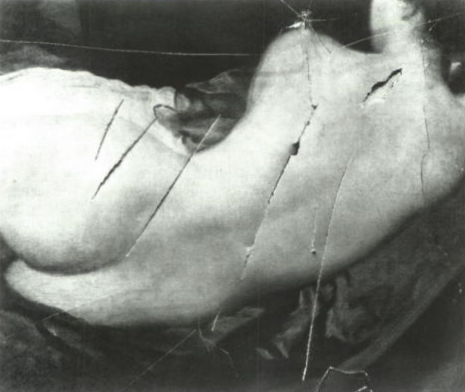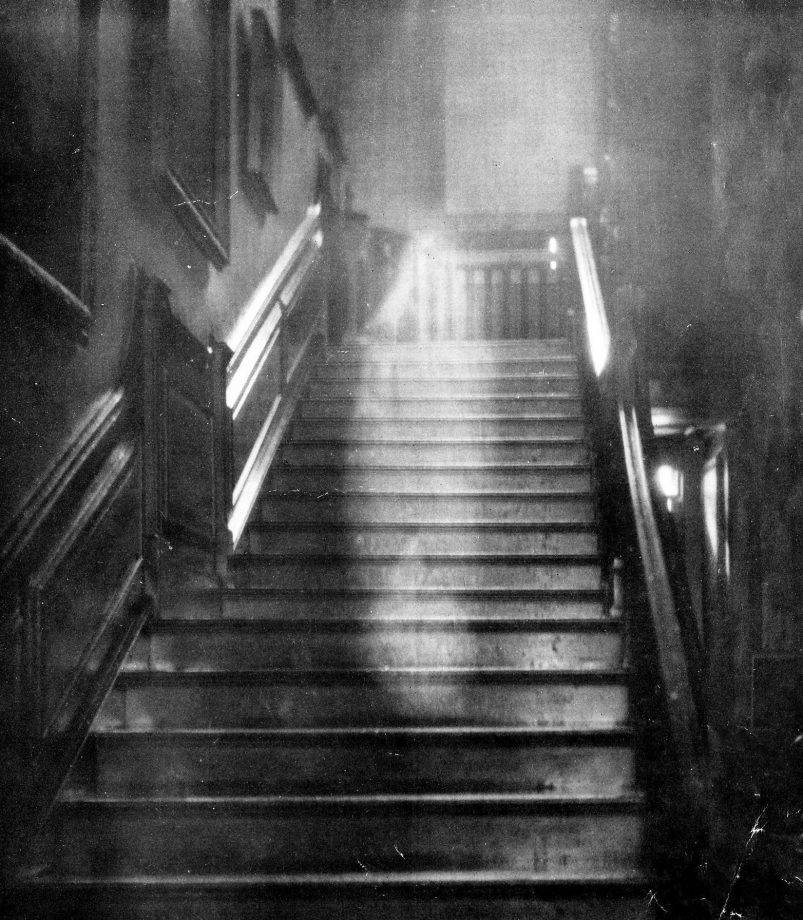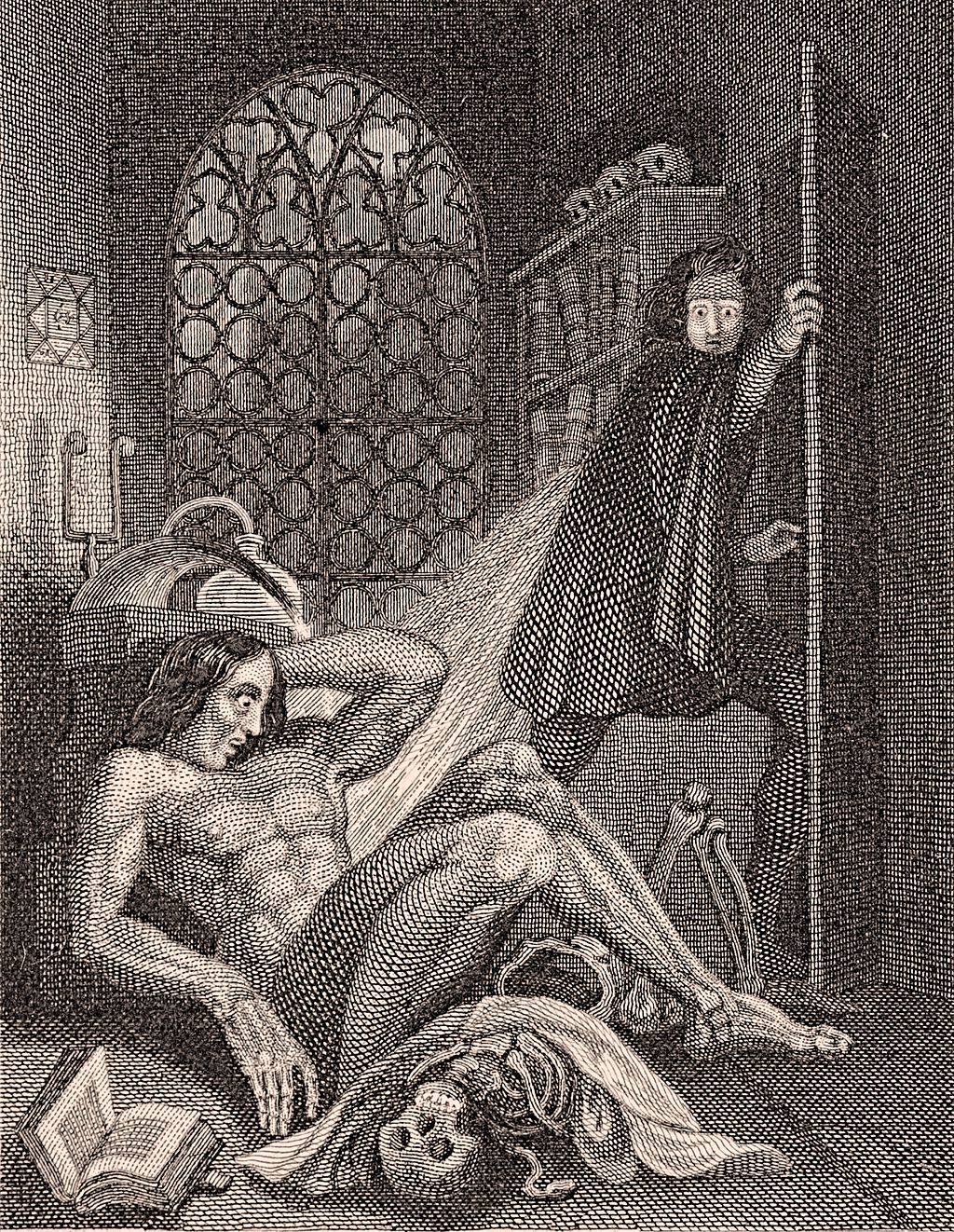by Amineddoleh & Associates LLC | Jan 24, 2024 |
What’s in a name? According to Banksy, quite a lot.
Banksy, the elusive and mysterious street artist, has retitled and redated a famous painting – for the second time.

Girl with Balloon (2006) by Banksy. Image via ArtNet.
The artist first renamed the work (originally called Girl with Balloon, 2006) in 2018, after it went through the shredder during a live auction – to the shock of those present in the crowd (unbelievers are welcome to watch the Youtube footage of the event, in case they missed it. Of particular hilarity is the auctioneer calling for everyone’s “attention” at the close of the footage, in an incredibly kind, polite and posh British accent).
It was a shocking moment, and one that caused a significant stir in the art world. However, Banksy was not done and continued to surprise the industry. Post-transformation, the artist (who remains anonymous) announced through the studio Pest Control that the work was now called (appropriately) Love is in the Bin, and given a new date (2018). The reason? According to Banksy, the intentional modification of the original work produced an entirely new piece.
What of the half-destroyed piece? Sotheby’s was in a bit of a pickle, as the work had been sold prior to going through the shredder. The auction house issued a brand-new certificate of authenticity with the new title. Next, in a moment of breathtaking diplomacy, Sotheby’s managed to sell the half-destroyed work to the original purchaser. Sotheby’s convinced the buyer to go through with the one million dollar sale (plus fees), and heaved a huge collective sigh of relief. The art world accepted the change and the new work as a product of Banksy’s unpredictable creativity and whimsy.

The half-destroyed work. Previously entitled Love is in the Bin (2018). Image via DW.
The Second Change
Years later, in October 2021, Love is in the Bin returned to auction at Sotheby’s. After selling for upwards of $25 million, the work underwent its second re-titling. The piece is now called Girl without Balloon and dated 2021.
Type-A personalities among us may wonder: is this allowed? Do artists have the power to revisit, rename, and re-date works after they enter the market? Surprisingly, the answer is yes. Artists have legal rights – called moral rights – which protect (among other things) artists’ rights of attribution and integrity. Moral rights are principally given through the Visual Artists Rights Act (VARA) (17 U.S.C. Sec. 101, 106A, 113, 301) and cover the non-economic aspects of artist rights.
Artists’ Moral Rights
The right of attribution (one of the four moral rights of artists included in the statute) gives artists the right to have their names attached to works they have created. Additionally, this right prevents the names of others who did not create the work from being attached to the piece. In Banksy’s case, this right came into play during the intentional partial shredding of the work at auction. Banksy directed the shredding, and then stated that the shredding produced an entirely new artwork – which he also created, vis-à-vis the art handlers at Sotheby’s.
A second important right included in the moral rights of artists is the right of integrity. The right of integrity gives the artists exclusive right to prevent the destruction or modification of work by others. Note that the prohibition is against changes to the work by others – the artist maintains the right to revisit and modify a work at any time (even if, at some earlier point, the artist had treated the work as finished). A modification arguably includes the title and date of a work.

Girl without Balloon by Banksy (2021). Image via NPR.
Where Do Banksy’s Title Changes Fit In?
Our founder, Leila, was interviewed on this very subject in 2015, regarding a piece by Frida Kahlo. When asked about the significance of a work’s title, in relation to an artist’s moral right of integrity, Leila stated:
“A title is a significant piece of a work. [Think] about Duchamp’s ‘Fountain.’ He took a urinal and named it a fountain, and then said it was a piece of art. It was just because he gave it a title and put it in a different context that changed the work in itself, and titles do have the ability to transform a work.” (Emphasis added).
Leila, along with other respected legal scholars, explains that the value of moral rights – such as the right of attribution and the right of integrity – is non-economic. Instead, moral rights encompass the rights of artists that stem from their artistic personas – their personality, style, creativity, whimsy, and studio brand. By protecting artist’s carefully constructed “personas”, the moral rights of artists act as a legal shield for the non-economic components of an artist’s body of work.
The result? Banksy is well within his moral rights as an artist to rename the piece. Banksy’s modifications and transformations of his piece – both physical and titular – reflect the ingenuity and creativity of this astonishing, mysterious artist.
Will the piece undergo another name change, and be given a new date? It’s anyone’s guess. For now, the piece is called Girl without Balloon (2021). But, that could change. As Shakespeare wrote, “We know what we are, but know not what we may be.”
by Amineddoleh & Associates LLC | Jan 23, 2024 |
Our firm is thrilled that this is Master Drawing New York’s (MDNY’s) first year with our client, Christopher Bishop Fine Art, at the helm. This highly-anticipated, week-long event is the premiere art exhibition of works on paper in the United States. Over two dozen galleries on the Upper East Side will feature rare and exquisite works on paper, in addition to some paintings, sculptures, and photographic works. The selected works range in date, with some pieces dating back to the 15th century.

Brochure cover for MDNY 2024. Image via Master Drawings New York.
Those who wish to walk the entire show (despite forecasts for rainy weather) will find that they easily meet their step-goals for the day – MDNY stretches 40 city blocks. In addition to the various exhibitions spanning the fair, several events and lectures will take place in different locations throughout the week. Those interested in attending should be sure to pick up an exhibitor map and calendar at one of several spots in the city, lest they miss out on an exclusive, once-in-a-lifetime event.
Highlights
One of the highlights of the fair comes from our very own client. Christopher Bishop Fine Art will exhibit The Pharoah’s Judgment, an exceptionally rare Spanish drawing discovered at auction in early 2023. The 16th century drawing contains tiny pin pricks throughout the pattern of the drawing. These pin pricks indicate that the pattern was replicated on ecclesiastical garments. MDNY has chosen to exhibit this work in a double-sided frame, in order to best showcase how the maker of the drawing collaborated with the embroiderers on the finished garments.This gives viewers a fascinating inside-look into artist collaborations in the 16th century.
Spirit of Partnership
Speaking of collaborations, this year marks the start of a new, great one. MDNY is partnering with The Drawing Foundation, a New York-based not-for-profit organization whose mission is to advance knowledge and scholarship about drawings. The Drawing Foundation establishes this goal through collaborations with various partners around the world. Our firm applauds MDNY, and, by extension, Christopher Bishop Fine Art, for engaging in this fresh collaboration with The Drawing Foundation. The partnership is sure to foster the newest generation of scholars, students, curators, and appreciators of artistic works on paper.
Collaboration – among artists, galleries, collectors, and audiences – hits at the heart of MDNY itself. The events this week are not to be missed, not only because they are a chance to experience gorgeous art, but because they present an opportunity for the international art community to come together in scholarship and art appreciation.
No one says it better than Christopher Bishop. “All of us who work with drawings — museums, dealers, collectors, and historians alike — are invested in seeing that the joy of the study of drawings is passed on to new generations. This can only be done by knitting the community together ever more strongly and introducing new audiences to the fair.”
by Amineddoleh & Associates LLC | Jan 5, 2024 |
Sotheby’s has had a rocky start to 2024 . The New York Times reports that the auction house is preparing to defend itself in trial next week, in the most high-profile lawsuit the art world has seen since in over a decade.

One of the works Rybololev purchased. Tête by Modigliani. Image via Sotheby’s.com.
Facts of the Case
A Russian oligarch, Dmitry Ryboloblev, is accusing Sotheby’s of aiding in fraud. The trial is based on transactions Sotheby’s oversaw between Rybolobev and a dealer/advisor named Yves Bouvier. Bouvier has been accused of secretly acting as both an art dealer and owner of works he sold to Rybolobev, while Bouvier also represented himself as an art advisor. According to Ryboloblev, playing multiple roles enabled Bouvier to dramatically inflate the estimated value of any art sold, and pocket the difference.
Sotheby’s has been accused of helping Bouvier in his deception. The auction house has been accused of knowing that Bouvier lied to Rybolobev about the price of the artwork that Bouvier paid for it, and then helping Bouvier to adjust the work’s valuation accordingly. It will be difficult to prove that Sotheby’s knew that Bouvier was lying to his client, Rybolovlev. However, the evidence presented at trial could convince a jury that Sotheby’s representatives knew Bouvier was inflating the estimated value of the artwork being sold.
The most damning evidence is (as it always is) found in the digital breadcrumbs: certain emails admitted into evidence indicate that Sotheby’s representatives might have altered their valuations based on Bouvier’s instructions –allowing them to both profit from the difference.
Founder Sought as Expert Voice
The lawsuit may expose some of the secrecy behind the world’s most expensive art dealings, primarily because it involves a jury trial. The entire art world is abuzz with intrigue about the trial, and our founder, Leila, was sought out as an expert voice on this incredibly hot topic.
Leila was quoted in The New York Times, stating “There is so much secrecy in the art world that buyers sometimes don’t know the amount of money being made by others in transactions. . . this case will help to clarify the responsibilities and fiduciary duties owed to clients by dealers and auction houses.”
Anonymity in the Art Market
Our firm previously wrote about the issues stemming from anonymity in the art market here. This new case is expected to further increase transparency around those issues in the art market. It asks difficult questions about where loyalties lie when expectations become blurred and prices shoot sky-high. Another outcome for this trial could be fewer money-laundering schemes hidden in art transactions, because more transparency would give bad actors fewer places to hide.
No matter how this case ends, this trial will be one to watch: it has the potential to initiate a complete overhaul of centuries-old industry practices for art buyers, sellers, auction houses, and dealers around the world.
by Amineddoleh & Associates LLC | Nov 6, 2023 |
Monday morning did not come easily for art lovers this week. Heartbreaking news broke early Monday that the glass to the infamous Rokeby Venus by Diego Velazquez was intentionally smashed. The culprits were taking part in a climate protest organized by Just Stop Oil (“JSO”).
Our firm wrote about JSO’s past string of protests here. We also have written about the mysterious Rokeby Venus – and its purported ability to drive viewers mad – here. Check both posts out to obtain context for this recent attack.

The slashed Rokeby Venus. Image via artinsociety.com.
It is odd that the painting at the heart of this strange, unsound attack was the alluring Rokeby Venus. Perhaps the same mysterious, deluded forces that have caused past owners and viewers to lose their faculties were at play?
JSO states that this piece was specifically selected – but not for its superstitions. Instead, JSO claims an arguably logical connection for choosing this painting for destruction. As JSO explained in a public statement on Nov.6th, “Women did not get the vote by voting [reference the 1914 attack by women’s rights activist Mary Richardson], it is time for deeds not words.”
JSO continued: “It is time to Just Stop Oil. Politics is failing us. It failed women in 1914 and it is failing us now. New oil and gas will kill millions. If we love art, if we love life, if we love our families, we must Just Stop Oil.”

JSO climate protestors in an outdoor demonstration. Image via juststopoil.org
The Met Police thought otherwise. The two culprits were arrested for causing criminal damage to the work. It’s safe to say that people in the art industry feel that these climate-driven protests have gone too far. Prior to this protest, JSO’s demonstrations have been merely superficial (and carefully planned as to not cause permanent damage). However, real damage was done this time.
Smashing the glass sets a new – and dangerous – precedent for possible protests in museums worldwide. Criminal-level damage to precious, irreplaceable piece of art and cultural heritage risks destroying crucial pieces of global history.
Our firm sincerely hopes that JSO will find new mediums through which to express their message. We encourage JSO to engage in productive conversations with politicians and global oil producers – and to leave the work of poor Mr. Velazquez (and his contemporaries) out of it.
by Amineddoleh & Associates LLC | Oct 31, 2023 |
Good news, thrill-seekers! Here at Amineddoleh & Assoc., not only do we provide exquisite legal services for our clients, we also know where to find a good, real-life scare. Our secret? Follow the haunted art!
Read on for our recap of our firm’s top haunted art-themed blog posts. Then, book a ticket to see the haunted art in-person. No tricks here, each destination is a true, Halloween treat.
Witch Way to the Party?
In this recent blog post, our firm traveled to Asheville, NC to get a glimpse at America’s Largest Home – and one of the most haunted. Click the link for all the details on this spooky mansion, including its most famous ghost-in-residence. Not only that, this historic home has a strange room known as the Halloween Room for visitors to experience, plus its own secret connection to protecting American art from Nazi air-raids in WWII. As if that weren’t enough to encourage a click, this post also has dazzling photos of Asheville’s gorgeous fall foliage.

Biltmore House in Autumn. Image via R.L. Terry at Wikimedia Commons.
The Ghoulishly Gory Frescos in Rome’s Santo Stefano Rotondo
Ever see art so gory it incites a physical response? Click here for more info on this real-life syndrome, known as Stendhal Syndrome, in which grotesque art and cultural heritage causes viewers to have palpitations of the heart. For those wanting to experience the syndrome in real-life, look no further than Santo Stefano Rotondo in Rome. While most tourists on a Roman holiday select beautiful frescos at the Vatican, those who venture to Santo Stefano will see a different sort of religious art. Go for the scenes of torture, stay for the bloody depictions of senseless violence. Plan to go before lunch, or else risk spilling the contents of your own stomach at the foot of these cultural works.

Gory frescoes covering the walls of the church. Image courtesy of Leila Amineddoleh, used with permission.
Cursed Art, from Statues to Paintings
Anglophiles, unite! The National Gallery in London is home to one of the most famous paintings in the world. However, this work is not famous for its artistic qualities (though they are divine). Rather, The Rokeby Venus is better-known for its ability to cause viewers to lose their minds. Click here to read all about this painting’s astonishing – and potentially cursed – provenance. The strange stories behind The Rokeby Venus illustrate how all aspects of a work’s life – including whether or not it is cursed – create its provenance. No matter what your opinion is of The Rokeby Venus’ alleged curse, the documented history of strange occurrences attributed to its ownership has become an important part of the work’s provenance.

The slashed Rokeby Venus. Image via artinsociety.com.
Haunted Happenings: The Law of Ghosts and Home Sales
If the average Airbnb isn’t scary enough this season, consider visiting a house that’s actually haunted. More and more people are reporting ghosts in domestic settings – and not always friendly ones. Trouble ensues when the place the ghost calls home is up for sale. Lawyers may be faced with the question: is a ghostly presence a condition that must be disclosed prior to sale? Would a reasonable family purchase a house that comes with a frightening ghost? Read more here to discover the actual laws that govern when a family’s new home comes with an unexpected side of ghost.

Famous ghost photograph of the Brown Lady of Raynham Hall, originally taken for Country Life (first published in December 1936).
Horrifying Provenance of Monster Manuscripts
This post provides two monstrous holiday destinations in one spooky swoop: ties to Mary Wollstonecraft Shelley’s Frankenstein can be found in both New York City and Oxford, England. Online versions of Shelley’s copious notes and edits for the story can be found on The Shelley-Godwin Archive’s website through the New York Public Library. To pay a visit to the originals, travel to Oxford, where the original transcript are held as part of the Abinger Collection in the Bodleian Library. If that weren’t reason enough to visit Oxford this time of year, stop by Christ Church College for the Harry Potter-esque tour of the storied grounds. Glimpse the inspiration for the wizarding world’s tall towers and cavernous halls on the college campus. Who knows – wizards also might be walking the grounds, masked in their muggle clothes.

Illustration from the frontispiece of the 1831 revised edition of Frankenstein, published by Colburn and Bentley, London 1831.
The Cat’s Meow: Feline Art Lovers
Word on the street is that the husband of our firm’s founder is dressing as a cat for the second consecutive year this Halloween. While we can neither confirm nor deny the Halloween costumes of our firm’s families (or whether or not, in fact, the members of those families were given the freedom to select their own costumes, or if they were selected for them by their young daughters), click here for a post inspired by our culture’s love for cats in art. Thinking of dressing as a cat this year? As our founder’s husband may say, ‘tis the season!
On behalf of Amineddoleh & Associates, we wish you a safe and Happy Halloween this year!










